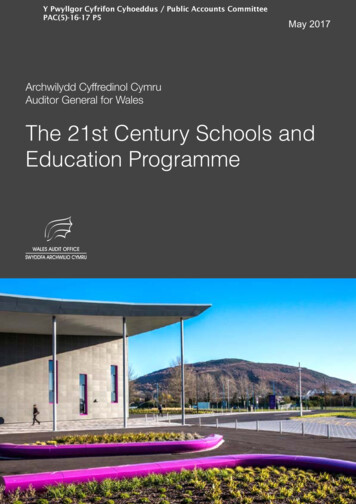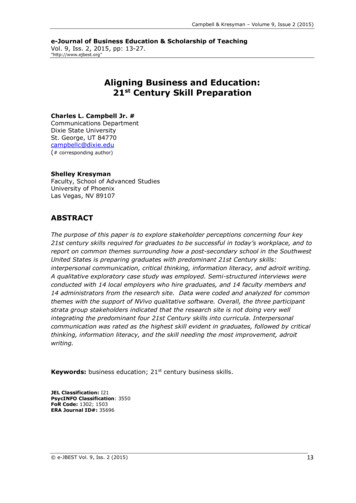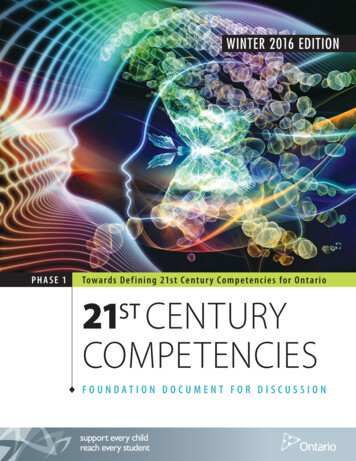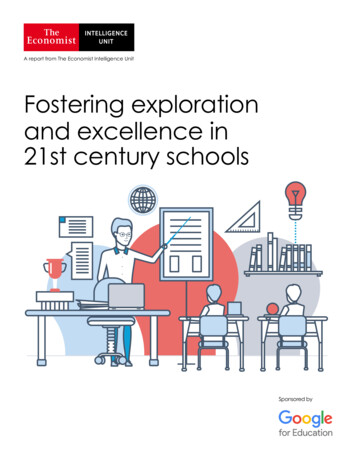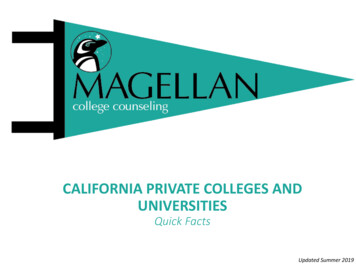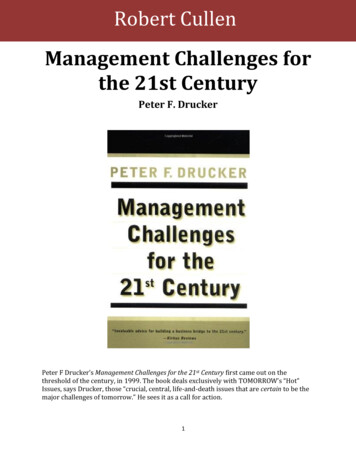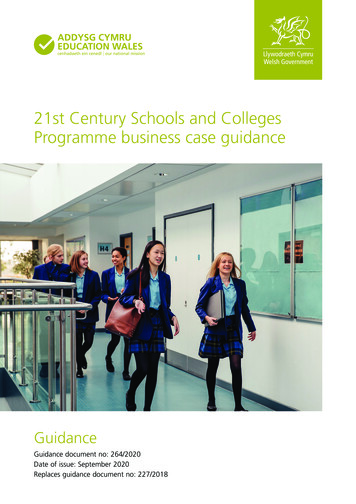
Transcription
21st Century Schools and CollegesProgramme business case guidanceGuidanceGuidance document no: 264/2020Date of issue: September 2020Replaces guidance document no: 227/2018
21st Century Schools and Colleges Programmebusiness case guidanceAudienceThis guidance is aimed at local authorities, further education institutions, diocesanauthorities, and higher education institutions.OverviewThe guidance and templates will assist those developing business cases forconsideration by the Education Directorate.Action requiredThe guidance should be used when preparing business cases for capital fundingfrom the 21st Century Schools and Colleges Programme.Further informationEnquiries about this document should be directed to:Education Business Planning and GovernanceThe Education DirectorateWelsh GovernmentCathays ParkCardiffCF10 3NQTel: 03000 257672e-mail: 21stcenturyschools@gov.wales@WG EducationFacebook/EducationWalesAdditional copiesThis document can be accessed from the Welsh Government’s website atgov.wales/21st-century-schools-programmeRelated documents21st Century Schools and Colleges Programme business case template (2020)Guidance for community benefits (2018)Publicity guidance for 21st Century Schools and Colleges Programmeprojects (2020)Mae’r ddogfen yma hefyd ar gael yn Gymraeg.This document is also available in Welsh. Crown copyright 2020WG41239Digital ISBN 978 1 80082 122 4
Contents1. Introduction2. Application process3. Assessment Process4. Project approval process5. Project monitoring and evaluation26202130The following annexes are provided separately and are not within this document:Annex 1: Business Case templateAnnex 2: Strategic outline programme (SOP) revision templateAnnex 3: Programme benefits tableAnnex 4: Options framework – worked example (SOC stage)Annex 5: School project benefits tableAnnex 6: Further education project benefits tableAnnex 7: Options appraisal template (worked example)Annex 8: Options appraisal template (blank)Annex 9: Size and cost standardAnnex 10a: OBC Project cost templateAnnex 10b: FBC Project cost templateAnnex 11: Project information proformaAnnex 12: Community benefits – project information proforma (guidance and workedexample)Annex 13: Closing report template and guidanceAnnex 14: Funding forecastAnnex 15: Variation form
1. Introduction1.1ContextThe 21st Century Schools and Colleges Programme is delivered by the Welsh Governmentin partnership with local authorities, further education institutions and dioceses.Welsh Government has developed this guidance to illustrate the specific business caserequirements of the Programme.This guidance should be read in conjunction with HM Treasury’s Green Book and Publicsector business cases using the five case model: update guidance.1.221st Century Schools and Colleges Programme backgroundThe first wave of investment, (Band A) of the 21st Century Schools and EducationProgramme, represented a 1.4 billion investment over the five year period ending 2018/19.All 22 local authority areas have benefitted from this major infrastructure programme, whichhas supported the rebuild and refurbishment of over 150 schools and colleges.The second tranche, (Band B) began in April 2019 and was expanded to include furthereducation colleges and renamed 21st Century Schools and Colleges Programme. ThisProgramme will see a further 2.3 billion investment in school and college infrastructure. Inorder to support the deliverability and affordability of deliver partners’ individualprogrammes, the Welsh Government grant intervention rate for capital schemes is now 65%of their cost.Voluntary Aided and faith schools will receive a grant intervention rate of 85%.In addition, to support facilities for pupils with additional learning needs and those in pupilreferral units, the Welsh Government intervention rate will increase to 75% for capitalschemes, with delivery partners meeting the remaining 25% of the costs.Educational transformation will remain a vital outcome of our investment in Band B of theProgramme. We also recognise that that it is hugely important that we address the conditionof our school and college buildings. Therefore the two key priorities of Band B are:Investment Objective One – to provide efficient and effective educational infrastructurethat will meet current and future demand for places by 2024. Backlog maintenance costs for the schools and colleges selected for Band B arereduced by at least 50% (based on the assumption that approximately 50% of theprojects in the Programme will be replacements for existing assets)No category D buildings in the estatec25% of Category C condition buildings are improved to Category A or BProvide the right number of places for the delivery of:o Welsh medium educationo English medium educationAddressing sufficiency issues where relevant.2
Working towards Net Zero Public Sector Buildings in line with Welsh GovernmentCarbon Reduction Commitments.Investment Objective Two – optimise the use of infrastructure and resources, to deliverpublic services for our communities by 2024. This will include flexibility of our assets so thatspace and facilities available for our stakeholders are maximised. Our aspiration is for all facilities that receive investment commit to making assetsavailable for community use including (but not solely) access to support services andprogrammes which promote community resilience and contribute to tackling poverty iflocal demand exists.10% of schools / colleges that receive funding from the Programme have co-locatedpublic services on site if local demand exists.Specifically: Are the schools or colleges affected in poor condition? Do the plans contribute to sufficient efficient provision? Do the plans result in enhanced use by the community?The reasoning behind this is to ensure that our educational infrastructure is of an acceptablestandard. Where there are identified educational needs (e.g. low school banding) this will bepicked up as part of the investment and necessary improvements made as a condition offunding.In all cases, individual projects within the programme will be assessed on: Extent of the strategic fit with national, regional and local prioritiesValue for MoneyDeliverability (affordable and timely)Affordability.Given our challenging economic environment, it is important that funding from all sources isconsidered. Band B will be funded through a combination of capital and revenue funding.For Band B of the 21st Century Schools and Colleges Programme, Welsh Ministers haveconfirmed that, in addition to the capital funding available for the programme, there will arevenue funding stream that will enable investment of around 500 million, using the MutualInvestment Model. This revenue-investment is intended to boost the amount of resource wehave available to support school and college infrastructure.For projects wishing to use the Mutual Investment Model, or who need further advice onhow to use this guidance for Mutual Investment Model projects please e-mailMIMMailbox@gov.walesAll submitted Business Cases are underpinned by a Strategic Outline Programme (SOP),which provides an overarching view of individual local authority / further education institutionstrategies. Individual projects can then be approved subject to receipt of a satisfactoryBusiness Case.For projects over 5 million, Business Cases are submitted in three stages: Strategic Outline Case (SOC) Outline Business Case (OBC) Full Business Case (FBC)3
For smaller projects less than 5 million in value the SOC, OBC and FBC are replaced by asingle document, the Business Justification Case (BJC).1.3Changes to processFollowing feedback we have reduced the need to repeat information already included atprevious business case stages unless they have changed.We operate on a principle of continuous improvement, and welcome your comments on thisguidance. We anticipate review of this guidance on a biennial basis.1.4Process overviewAll Business Cases will be based on the five key areas that underpin the Better BusinessCase Process (Five Case Business Model).Strategic CaseHow does the proposal fit strategicallywith government/local priorities?What is the case for change and are thereclear SMART investment objectives?Economic CaseWhat are the options for delivering theinvestment objectives and which oneoptimises value for money?Commercial CaseHow can a deal be done with deliveryagents?What are the procurement strategy andthe commercial arrangements for theproposed investment?What is the Community Benefits plan?Has the Project Bank Accounts policybeen considered? Will a Project BankAccount be used or have compellingreasons not to use one been identified?Financial CaseIs the proposal affordable?What are the sources of match fundingand what is the accounting treatment ofthe investment?Management CaseHow will the successful delivery of thescheme and whole life benefits bemanaged?4
These five areas are examined at different stages of the business case process. The SOC will focus on the strategic justification (Strategic Case), investmentobjectives for the project (Strategic Case), the reasoning behind reduction of the longlist to a short list of options (Economic Case), the outline cost of the project (FinancialCase) and the proposed management structure (Management Case). The OBC will focus primarily on the commercial strategy (Commercial Case), thedetailed analysis of the options appraisal and benefits (Economic Case), details ofmatch funding and profile of spend (Financial CaseThe Strategic Case will only berevisited if it has changed since agreement to the SOC. The FBC will solely focus on the tendered costs unless anything has changed sinceagreement to the OBC.For smaller projects, the BJC covers all of these areas in a single iteration. In certain situations, it may be possible to combine Business Cases, and submit a jointSOC/OBC or a joint OBC/FBC. This is appropriate for Business Cases that are relativelystraightforward (i.e. not contentious, like for like replacements etc.) or lower valueinvestments.Additionally, we will be working closely with local authorities to ensure that Pupil ReferralUnits (and other EOTAS settings where appropriate) are considered in their Band B bids.5
2. Application process2.1BackgroundBusiness cases map to the stages of development of your project and provide break pointsthat enable key decisions to be made.Because of the different decisions being made at each stage, different levels of informationare required to support the case.To reflect the different information requirements, templates have been created that ask keyquestions that will allow us to gather the appropriate information for each stage of theprocess.All relevant information should be contained in the body of the document. With theexception of the Option Appraisal Template, Project Benefits Table, Project Cost Template,Project Information Proforma and Funding Forecast which are to be attached asappendices, any other annexes / appendices will be disregarded. Business cases shouldalso be page numbered.2.2Strategic Outline Programme (SOP)SOPs have been devised to assist the development and agreement of programmes insupport of an agreed strategy/strategies. This document captures the purpose of theinvestment at a strategic level.Although this guidance predominantly deals with SOC, OBC and FBCs, there may beoccasions where it is necessary to amend your SOP to reflect a change in direction or anidentified need for an increase or decrease in resources.The process for such a change is as follows: Raise the issue with the appropriate Welsh Government contact:o Programme Directoro Head of Capital Fundingo Head of School Reorganisationo School Reorganisation Manager Submit a form that explains the purpose for the change and the implication toobjectives, options and funding. Please refer to SOP Revision Template (Annex 1). This application will be considered by the Education Directorate’s Investment Paneland any recommendation for approval forwarded to the Minister for Education forfinal approval.You will also be required to complete a Programme Benefits Table (Annex 3) to identifythe current position and the impact that your different options will have.6
2.3Strategic Outline Case (SOC)At an early stage, the main purpose of the SOC is to: establish the need for investmentappraise the main options for service deliveryprovide a recommended or preferred way forward for further analysisprepare and appraise the long list of options within the economic caserecommend a preferred way forward together with indicative costs, for more detailedanalysis within the OBC.In practice, this entails building on local and governmental strategy documents to make thecase for change within the strategic case. For example, alignment with: The Wellbeing of Future Generations (Wales) Act 2015Taking Wales ForwardWelsh Language policyChild Poverty StrategyQualified for Life30 hour childcare offerInfant class size capital grantWelsh in Education Strategic Plans (WESP) – it is really important that yourplans align with the WESP for your area. Please highlight how you will meetlocal needs for Welsh medium provision/ expand/ move along the continuum.Local Development PlansPupil numbersPlease note that the SOC should be prepared in accordance with best practice guidanceprovided in HM Treasury’s Green Book.During Band A the programme operated a two-stage process of funding so that someeligible activity costs incurred at OBC stage could be released following Ministerial approval.For Band B this practice has been extended so that payments can be made at both SOCand OBC stage to enable improved delivery of the programme.Eligible activity costs could include: Cost of site surveys including ecology Acoustics Ground investigation Pre-construction costs such as design fees, planning, project and cost management.2.3.1. Executive summaryThis should be a concise summary of your findings. It should cover the following: What do you want to do?What is the estimated cost?What is the proposed completion timeframe?Why do you need to do it?What will it achieve in terms of benefits to condition, capacity and reduction ofmaintenance costs?7
Have you considered the guidance in the School Organisation Code? Do you need to carryout consultation and publish a statutory notice? If so could will this affect your timescales?2.3.2 Strategic caseThis is one of the most important components of this document and should clearly identifythe following: Strategic FitCase for changePlease refer to Business Case Template (Annex 1) for full list of questions to beaddressed under Strategic Fit and Case for Change.2.3.3 Economic caseThe Economic case draws heavily from HM Treasury’s Green Book.At each stage of the business case process, you will be required to complete a School orFurther Education Project Benefits Table (Annexes 5 and 6) to identify the currentposition and the impact that your different options will have.The purpose of the Economic Case at the SOC stage is to identify your long list of optionsand reduce it down to a short list.To do this, it is important to identify the critical success factors. These might typicallyinclude: Do the short-listed options fit with local / national strategies?Do they provide good value for money?Are the options deliverable?Are the options achievable in the timeframe?Are the options affordable?Are the options socially/politically acceptable?Do they provide better outcomes for learners?Do they enable resources/facilities such as sports facilities and pitches to be used bythe local community thereby helping to improve sustainability?Do they support different styles of teaching and learning?Do they support pupil wellbeing and provide better outcomes for learners, includingdisadvantaged pupils?Each option should be assessed against both the investment objectives and critical successfactors and carried forward or discounted as appropriate. The Value for Money assessmentshould consider, in so far as possible, on-going operational costs such as the requirementto provide free transport to pupils on grounds of distance or lack of safe walking routes.It is useful to address these questions in a workshop. Attendees should represent thegroups affected by the project, as well as members of the project team. It is important thatyou note who attended the workshop held to generate the long list of options and recordwhen the workshop was held.8
As a minimum, each option should include: a brief description of the option;a recording of each option’s advantages and disadvantages;a recording on the conclusion reached in respect of the option;the reasoning behind any decision made, particularly when an option is discounted.In terms of the generation and analysis of your long list of options, the options frameworkenables consideration of a wide range of options and provides a methodology to develop ashort list of options for further analysis at OBC. The short list of options should alwaysinclude a ‘status quo’/do minimum’ option.The options framework comprises: Scope (coverage: who, what, where etc.)Service Solution (how: technical)Service Delivery (who: provider)Implementation (when: phasing & time)Funding (how: )Please refer to Options Framework – Worked Example (Annex 4)At this point, a brief analysis should be undertaken around the indicative economic costs ofthe shortlisted options; remember to adopt a proportionate approach and make allowancesfor optimism bias.This work should enable identification of a preferred way forward at this time, subject tomore detailed analysis in the OBC.2.3.4 Commercial caseThis part of the business case must Identify your proposed procurement route. Compliantly tendered arrangements thatoffer opportunities for Wales based contractors will be favoured e.g. use of aregional framework such as SEWSCAP, South West Wales Regional ContractorFramework (SWWRCF) or North Wales Construction Partnership constructionframework for schools and public buildings or via a separate OJEU Procurementroute. Identify your Community Benefits (CB) approach and objectives if they are known atthis stage, including but not limited to a statement on how clients will promoteo sub-contract opportunities for Wales based businesses ando supply of Welsh or UK sourced steel on projects where steel is a majorcomponent;o Employment and training opportunities for disadvantaged persons especiallywhere projects are in areas of high deprivation and joblessness in Wales Confirm the project will capture CB outcomes / results via the Community BenefitsMeasurement Tool and report these to Welsh Government’s Value Wales via the CBmailbox CommunityBenefits@gov.wales Confirm that a Project Bank Account will be applied or details of the compellingreasons for not doing so, in line with Project Bank Accounts policy. Confirm that were a Project Bank Account is to be used that the requirement will beterm of contract.9
2.3.5 Financial caseAt this stage only limited information is needed. You should: identify the estimated cost of the preferred way forward broken down over financialyears by submitting a Funding Forecast (Annex 14)identify how this will be funded.Is the project part of batch procurement? If not, what consideration has been given to thisapproach? Has the financial loss of not adopting this approach been assessed?Please note that Welsh Government applies strict cost and size parameters to the capitalvalue of projects within Band B of the Programme in order to maximise value for money andensure that as many students as possible benefit from a 21 st Century learning environment.Therefore, and learning from the lessons of Band A, Welsh Government will provide fundingfor Band B capital funded projects to a maximum of 65% of an all-inclusive cost per squaremetre (m²). This is set at 2,775 per m² (2019) multiplied by the recommended maximumarea set by BB98/99. Welsh Government have adopted this formula to create an overallproject cost as we believe it is based on a generous interpretation of average market ratesand have noted that many excellent school facilities in Wales and elsewhere in the UK havebeen successfully delivered for an all in project cost of considerably less than this figure.These area and cost parameters should also be used when working out the notionalequivalent capital cost of MIM schemes in the first instance.It is important that any significant likely abnormal costs are flagged at SOC stage wherepossible in order for this to not add any additional delay to the approval of your businesscases.Please refer to Cost and Size Standard (Annex 9) for a full list of what is included inproject costs and what would be considered as abnormal costs.2.3.6 Management caseThis should explain the governance of the scheme and how it is an integral part of the localauthority/further education institution 21st Century Schools and Colleges Programme. Itshould also explain how the project will be managed within the local authority/furthereducation institution, the resources required and the risks to delivering the projects and howthey will be managed.For example:“The following arrangements will be put in place to ensure the successful development ofthe scheme and production of the OBC.The project will be managed in accordance with Prince2 methodology.Any assurance e.g. Gateway Review, which has been undertaken on the programme, inconjunction with agreement to the SOP. The consequent actions are as follows TheMilestone activities are as follows .”It would be useful to also include references to early plans/proposals for benefits realisationor evaluation.10
2.4Outline Business Case (OBC)The main purpose of the OBC is to: revisit the SOC, highlighting any changes or confirm there are no changesestablish the option which optimises value for moneyoutline the deal and assess affordabilitydemonstrate that the proposed scheme is deliverable.In practice, this entails: updating the strategic case if appropriateundertaking investment appraisal within the economic casecompleting the commercial, financial and management cases, with supportingbenefits and risk registers.Sign off of the OBC provides agreement that a tender process can now take place.By OBC stage, you will have already undertaken site investigation and incurred design andmanagement costs.At the point that your OBC is signed off, you will be entitled to claim for eligible costsincurred to date.A Project Cost Template (PCT) should be completed and submitted with the OBCsubmission. The PCTs are used by Welsh Government to ensure alignment with the 21stCentury Schools Cost and Size Standard.Please refer to Project Cost Template (Annex 10a).For full list of what to include within theOBC, please refer to Business Case Template (Annex 1)2.4.1 Executive summaryThis should be a concise summary of the proposal.2.4.2 Strategic caseAt OBC stage it may be necessary to note any changes to the Strategic Case since SOCstage.2.4.3 Economic caseAt OBC stage it is vital that a convincing and comprehensive Economic Case is provided.At each stage of the business case process, you will be required to complete a School orFurther Education Benefits Table (Annexes 5 and 6) to identify the current position andthe impact that your different options will have.Short-listed optionsRestate the shortlisted options as identified in the SOC. Any changes should be highlighted.11
The economic appraisal should provide an overview of the main costs and benefitsassociated with the shortlisted options. This will be supported by the detailed financialanalysis. Please see Options Appraisal Template – worked example (Annex 7) andOptions Appraisal Template – blank (Annex 8).Information around costs and exclusions are included in the HM Treasury Green BookGuidance on Options Appraisals. The economic analysis focusses on value for money andshould: use constant (base year) pricesinclude opportunity costsinclude all quantifiable costs, benefits and risks to both organisation and widersocietyinclude environmental costs; make allowances for optimism biasexclude all Exchequer ‘transfer’ payments – for example, VATexclude general inflationexclude sunk costsexclude depreciation and capital charges.A new build school or college should be assessed over a sixty year period. Refurbishmentof a school or college should be assessed over a thirty year period.As well as the quantifiable costs and benefits, an analysis of qualitative benefits should alsobe included. This should be undertaken by identifying the benefits criteria relating to each ofthe investment objectives. The method used is as follows: weight the relative importance (in %) of each benefit criterion in relation to eachinvestment objectivescore each of the short-listed options against the benefit criteria on a scale of 0 to 9derive a weighted benefits score for each option.The results of this analysis should also be summarised together with the reasoning behindthe weighting and scoring of benefits. Aim to include independent participants in theanalysis to ensure that decisions are as objective as possible and not biased by apreference for a particular solution.While the assessment of qualitative benefits is important, it is critical that the quantitative(essentially NPV or NPC results) and qualitative (weighting and scoring) analyses“complement each other” (Green Book, page 38). If they suggest different options shouldbe pursued, then the Green Book suggests further analysis is undertaken before thepreferred option is identified.Benefit Criteria andWeightOption 1Option 2Option 3Option 4Raw (R) and weighted(W)scoresRRRRWWBenefit Criteria 1Benefit Criteria 2Benefit Criteria 312WW
Benefit Criteria 4Benefit Criteria 5TotalRankRisk appraisal – Qualitative (unquantifiable)The risks associated with the scheme must be identified, prioritised and appraised in allinstances.In the case of significant, new and/or high value investments, the risks should be quantifiedin s and included in the economic appraisals (‘cost of risk retained’). In the absence of riskmeasurement (in s), a sum should be included for optimism bias. All other risks: those thatare unquantifiable in s, should be appraised as shown below.In the case of medium and small sized schemes, it may suffice at this stage to weight andscore the risks for each option and to rank accordingly, see below.Whatever the approach, a sum must be included for optimism bias in the economicappraisals.Ideally, the risks should be quantified (in s) in all cases and the unquantifiable risksassessed as outlined below. In most instances, you will find the service risks associatedwith the design, build and operation features of the scheme fall in the former category, whileassociated business risks fall into the latter. External environmental risks, for example,inflation, may be ignored for the purposes of this appraisal, given that they are common toall options.Risks in respect of each of the options should be recorded and scored.Following the three elements of analysis: Economic, Benefits and Risk, a summary tableshould be produced.Evaluation ResultsOption 1Option 2Option 3Option 4EconomicappraisalsBenefits appraisalRisk appraisalOverall RankingThe conclusion should then be reached that the preferred option is ‘X’ and provide reasons.Sensitivity analysisIt is important that the sensitivity of the preferred option is tested through:13
‘switching values’ scenario planning / analysis (‘what if’) by altering the values of the ‘uncertain’ costsand benefits to observe the effect on the overall ranking of options.The results of this testing should be recorded in the OBC and whether this has changed thepreferred option ranking.2.4.4 Commercial CaseThis section of the OBC outlines the proposed deal in relation to the preferred optionoutlined in the economic case. It should also revisit the SOC Commercial case to re-iterateor elaborate on The procurement route to be takenCommunity Benefits approach / plans and objectives if known at this stageThe commitment to use Project Bank Account that the requirement will be made aterm of contract2.4.5 Financial caseThe purpose of this section is to set out the financial implications of the preferred option byfinancial year (as set out in the economic case section) and the proposed deal (asdescribed in the commercial case).As the Welsh Government is paying for 65% of the project, it is important that we areconfident that the remaining 35% of the project is affordable. Welsh Governmentcontribution will be capped and local authorities and further education institutions will beexpected to deliver within this budget.At this point in the project development, local authorities and further education institutionsshould identify the sources of match funding and confirm that these are signed up to by therelevant parties in the local authority / further education institution.For example:Capital Receipts: Have these been received? Are they ring fenced for the project? If theasset is not yet sold, what is the basis of valuation? When will the money from the sale bereceived? Will the timing of any sale impact on the project cash flow?Capital Funding: Has this been signed up to by the Cabinet / Board? If so, when was thismeeting? If not, when will this proposal go before the Cabinet / Board for sign up? Includeminute details.Prudential / Other Borrowing: Has the borrowing been secured? Has a revenue streambeen identified to fund the borrowing? Has a sensitivity analysis been carried out to ensurethat the borrowing is affordable if any circumstances change?Savings achieved through school reorganisation: Have the relevant consultations beenundertaken to achieve the proposed reorganisation? Has the Cabinet/Board confirmed thatthey are happy to ring fence this released revenue for
sector business cases using the five case model: update guidance. 1.2 21st Century Schools and Colleges Programme background The first wave of investment, (Band A) of the 21st Century Schools and Education Programme, represented a 1.4 billion investment over the five year period ending 2018/19.


